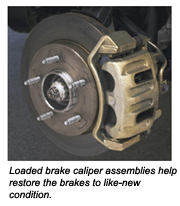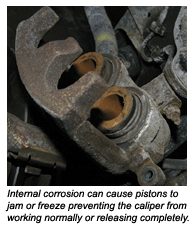Some technicians and parts professionals like loaded and semi-loaded calipers because almost everything they need comes in one box. They don’t have to worry about mismatched parts from different suppliers and the complete assemblies are quick and easy to install. Most importantly, they see fewer comebacks because of brake noise or other problems. Also, the assembled caliper can save time and make difficult brake jobs more profitable.
 The term “loaded caliper” indicates a caliper that includes a caliper, hardware and friction. This assembly is ready to bolt on the vehicle in most cases. Some suppliers are even including the caliper bracket for some applications. A “semi-loaded” caliper is a caliper that includes just the hardware and no friction. This leaves the friction material selection up to the technician. Some people in the industry now refer to a caliper that is sold alone as “bare” or “naked.”
The term “loaded caliper” indicates a caliper that includes a caliper, hardware and friction. This assembly is ready to bolt on the vehicle in most cases. Some suppliers are even including the caliper bracket for some applications. A “semi-loaded” caliper is a caliper that includes just the hardware and no friction. This leaves the friction material selection up to the technician. Some people in the industry now refer to a caliper that is sold alone as “bare” or “naked.”
Loaded calipers do provide a variety of benefits when doing brake jobs on customer’s vehicles. Most brake suppliers have a loaded and semi-loaded caliper programs today so availability is seldom an issue. Price, in some shops minds, remains the main hurdle to buying loaded calipers, but one comeback can change their minds.
One of the main advantages for the technician is that loaded caliper assemblies help restore the brakes to like-new condition. Not only do they get new friction, but also a new or professionally remanufactured caliper and properly matched hardware (shims, bushings, slides, etc.). This significantly reduces the risk of future leaks developing, and uneven braking or pad wear caused by calipers hanging up or dragging.
 Many technicians have learned the hard way that attempting to rebuild old calipers is often a waste of time. In many instances, the old calipers are so badly corroded or worn, they can’t be rebuilt or they leak when they are put back on the vehicle. Disassembling a caliper to replace the piston seal and dust boot is a messy job, and may be difficult or impossible if the piston is stuck in place. Steel pistons often can’t be reused because they’re too badly corroded, and scratches or pits in the caliper bore may cause the caliper to leak even after a new piston and seal are installed. That’s why most technicians prefer to replace old calipers with new or remanufactured calipers.
Many technicians have learned the hard way that attempting to rebuild old calipers is often a waste of time. In many instances, the old calipers are so badly corroded or worn, they can’t be rebuilt or they leak when they are put back on the vehicle. Disassembling a caliper to replace the piston seal and dust boot is a messy job, and may be difficult or impossible if the piston is stuck in place. Steel pistons often can’t be reused because they’re too badly corroded, and scratches or pits in the caliper bore may cause the caliper to leak even after a new piston and seal are installed. That’s why most technicians prefer to replace old calipers with new or remanufactured calipers.
Caliper piston seals don’t last forever, and once they start to leak, it’s the end of the road for the caliper and the pads. Fluid leaks are dangerous because they can lead to a loss of hydraulic pressure in the brake circuit that may cause the brakes to fail. Brake fluid leaking from a caliper can also contaminate the brake linings and cause them to grab or pull.
A caliper may also have to be replaced if it is sticking. Internal corrosion can cause pistons to jam or freeze preventing the caliper from working normally or releasing completely. Corrosion on the caliper mounts, bushings or slides can also cause problems by preventing a floating caliper from moving normally when the brakes are applied. The result here may be uneven pad wear, uneven braking, dragging or a pull. With a loaded caliper, the caliper is replaced along with the pads.
Replacing the hardware is important, because old corroded hardware can cause braking problems. We’ve heard of shims that have worked loose and caused a rotor to fail by rubbing and cutting through the rotor hat! If a technician forgets to install an anti-rattle clip or installs one that doesn’t fit properly, the newly installed pads may be noisy. Loaded calipers reduce these risks by providing the proper hardware and replacing everything that should be replaced.
The type of friction material that’s included with a loaded caliper assembly is critical because it should be the same, or better than the original. To avoid a mismatch of friction side-to-side, when installing loaded calipers on a vehicle, both calipers should be replaced at the same time. If only one caliper is being replaced, be sure to use the same friction pads on both sides.
Additional Sales
When a caliper is installed, the brake system should always be flushed and refilled with clean, fresh brake fluid that meets the OEM requirements for the application (DOT 3 or 4 fluid).
Even if a caliper is loaded, specialized brake greases and lubricants will be needed for installation. Caliper slides and bushings should be lubricated with a high-temperature brake grease, and related brake components, such as hoses, lines, rear wheel cylinders and the master cylinder, should all be inspected to make sure these components are in good working condition and are leak-free.
Cores Issues
When returning brake caliper cores, make sure everything is in the box. If the manufacturer included new brackets, make sure to include the old part. Rear brake calipers should also include and emergency brake hardware that was replaced with the new loaded caliper.
If the brake caliper is aluminum, like on the Chevrolet Malibu, make sure that you look at the core for corrosion around the inlet port where the banjo fitting makes contact. The two dissimilar metals create galvanic corrosion that can lead to pitting of the surfaces. Make sure to check with your parts suppliers on the core policies for these types of calipers. Also, look for damaged threads in the inlet port installing an aluminum caliper. Someone might have damaged the threads and not told the parts store before returning the part.
Loaded and semi-loaded calipers generally provide good value for the money and can lower repair costs when price is an issue. If you choose to install loaded calipers, look for a supplier that has a good reputation and stands behind its products.













